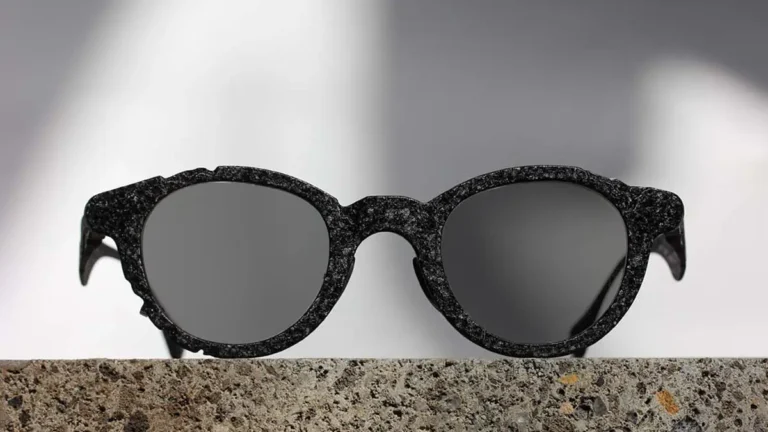Edward Gucewicz shares his creative secrets, from his beginnings as a fashion designer in London to the establishment of the brand in Japan. With personal anecdotes and technical insights, dive into the world of Japanese titanium and learn how brutalist architectural inspiration gave birth to some of the most fascinating frames showcased at SILMO 2024.
Parisee -. In order to introduce yourself, could you please explain me how you started to design some glasses ? For how long have you been an eyewear designer ?
E. Gucewicz -. I was a fashion designer before I began designing glasses. I worked for a couture house in London at the end of the 2000s . I started designing eyewear gradually over the last 12 years and glasses design has grown to be my predominant creative outlet.
Previous to T-Generations, I founded an umbrella manufacturing company. We had a factory in North London creating Luxury bespoke umbrellas that mixed traditional and modern manufacturing techniques and styles. I left this company in 2017 to focus on eyewear design.
Parisee -. When did you start working for T-Generations ? Can you tell me more about the brand in Japan ? What is your target customer ?
E. Gucewicz -. I started working on T-Generations in 2021. It was not initially planned to establish the brand in Japan, but no one could manufacture the glasses to the quality I wanted, except in Japan. So We eventually registered our brand in Japan. I also love Japan : I’ve worked with Japanese companies before on collaborative projects and I occasionally live there for a month or so every year now.
Our Target customer is someone who recognizes luxury finish and quality detailing, and yet retains a healthy sense of humor and curiosity
Parisee -. What are the specific features and possibilities offered by Titanium in eyewear design?
E. Gucewicz -. At T-Generations we’re using titanium to build eyewear designs that would normally be manufactured in acetate. An advantage of building in titanium is we can include finely carved details – such as the deliberate damage and chip marks on the frame- details that would be impossible to carve so precisely on acetate frames. The second advantage is our glasses can have unique tactile qualities because of unusual paint finishes and textures: The frame itself feels cold because it is metal, it is impossible to replicate this feeling in acetate. The texture can feel like stone. T.-Generations eyewear feels very luxurious to touch in a way that is truly unique.
Parisee -. Can you present and explain me a model that you have designed and you are especially proud about ?
E. Gucewicz -. “SOFT BRUTALISM” is one of my favorite designs. It presented technical challenges, particularly in integrating unusually placed rim locks and a hidden flexible spring hinge within the solid titanium temple ends.
Artistically, it embodies a duality that I find fascinating. At first glance, it appears quirky and unconventional, with deliberate damage marks and visible screw heads, reminiscent of bone grafting pins, along with a surface that subtly sparkles as light reflects off the cracked paint finish. When worn, this pair of glasses undergoes a subtle transformation: What may first appear quirky and unusual becomes more subdued, offering a refined and wearable look. The design is both sympathetic and flattering, quietly enhancing the wearer’s style. If someone walked past wearing them, you might not immediately notice anything out of the ordinary, but you’d sense that there’s something distinctively special about them. Their discreet eccentricity is something I deeply appreciate, reflecting a uniquely Japanese aesthetic that I aim to incorporate into my work. For me, frames should be unique without dominating the wearer’s personality.
I strive to create eyewear that feels innovative in your hand, but once worn, becomes an extension of your personal style. The “SOFT BRUTALISM” design embodies this balance.
Parisee.- At Silmo, you explained to me that you were using some painting usually reserved for architecture. Can you tell me more about this choice and why you have decided to use it for glasses ?
E. Gucewicz.- I did this so that people would want to touch the glasses, would want to stop and pick them up. The specific architectural paint we have used is applied in a way so it deliberately cracks when it cures. This creates an interesting texture. Combined with the cool temperature of the titanium under the paint, it is difficult to know what material the glasses are made out of. People find this intriguing.
Parisee.- How do you imagine the future of eyewear design ? Do you have some new project you can tell me about ?
E. Gucewicz.- Something I have noticed is that design technology such as improved 3D modeling software and AI assistance will make eyewear design look more organic, and become more materially efficient and therefore more aesthetically experimental.
Manufacturing technology such as metal 3D printing will enable the production of this coming new wave of design. Manufacturers will also provide designers with more inspiration as these factories continue to develop new methods of production and new finishes.
My concern with this is that the future of eyewear is about to get too experimental and sometimes messy with some hyper experimental designs that are artistically fascinating, but not flattering. Not sexy. I believe That technological innovation should always be tempered by the beauty of classic design. I love experimenting with technology, but I don’t call this true progress if the cost is to abandon beauty or charm.
A new project I’m working on for T-Generations are frames that have radically altered components, instead of hiding the hinges, I want to make them bigger, instead of hiding the screws, I want to make them into decorative features in their own right. Mechanisms are beautiful and don’t need to be hidden. The same way that a beautifully made wrist Watch may have a visible mechanism, I want people to appreciate the mechanisms of eyewear. I hope to be showing these new designs at Mido 2025.
T-Generations doesn’t just create eyewear; it redefines the codes of luxury optics. By combining Japanese craftsmanship with an artistic approach inspired by brutalist architecture, the brand manages to create frames that blend character and discretion. Edward Gucewicz, with his unique vision of balancing technological innovation with classic aesthetics, reminds us that the true value of design lies in elevating beauty without sacrificing the human essence.
For those seeking the exceptional, T-Generations frames are more than just an accessory—they are an experience to be lived.



